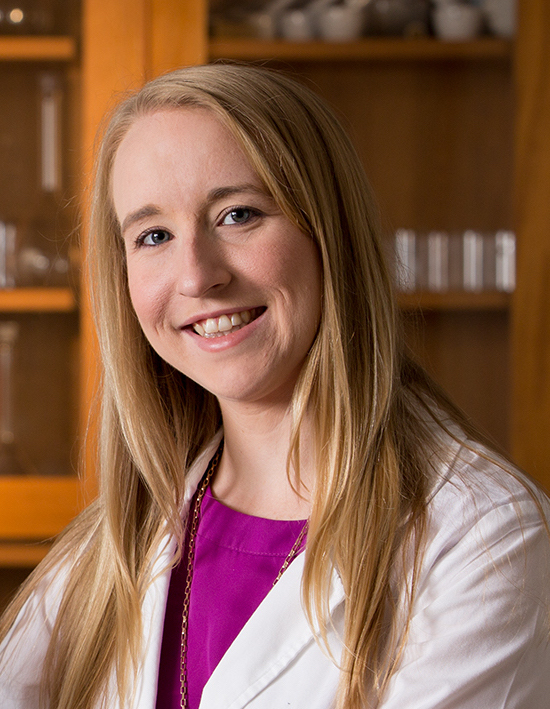A key focus area for the Integrated Food Safety Centers of excellence is to train and educate the future workforce. To accomplish this, the Tennessee CoE offers graduate assistantships through the University of Tennessee Knoxville and internships with Tennessee metro, regional, and central offices. Through these opportunities students are exposed to a range of projects focused on food safety in Tennessee and beyond.

Position: Postdoctoral Research Associate, Department of Food Science, University of Tennessee
Degrees: Ph.D. – Food Science and Technology, University of Georgia; M.S. – Food Science and Technology, University of Georgia; B.S. – Food Science and Human Nutrition (minor in Chemistry), University of Florida
Lauren’s main research focus is using computational tools to analyze whole-genome sequencing (WGS) data to determine population structure and genotypic characteristics of foodborne pathogens (Listeria, Salmonella, Campylobacter) to improve public health surveillance and aid in epidemiological outbreak investigations. She works closely with the Tennessee Department of Health and the Tennessee Integrated Food Safety Center of Excellence (CoE) in her research and other efforts (training, outreach, and teaching), with the goal of bridging the gap between foodborne pathogen genomics and state public health epidemiologists.
Genomic characterization and phylogenetic analysis of Salmonella enterica serovar Javiana
Salmonella enterica serovar Javiana is the fourth most reported serovar of laboratory-confirmed human Salmonella infections in the U.S. and in Tennessee (TN). To better understand Salmonella ser. Javiana microbial population structure within the state, we completed a phylogenetic analysis of Salmonella ser. Javiana clinical isolates from TN and found that the population structure consisted of three genetic clades. We performed a pan-genome-wide association study (pan-GWAS) to compare gene content between clades and found that the majority of genes that were over-represented in specific clades were located in mobile genetic element (MGE) regions. Using a 5, 10, and 25 hqSNP distance threshold, nine, 12, and 10 potential epidemiologically-relevant clusters were identified, respectively.
Additionally, we completed phylogenetic analyses of global Salmonella ser. Javiana datasets to gain a broader insight into the population structure of this serovar. We found that the global phylogeny consisted of three major clades (one of which all of the TN isolates belonged to) and two cgMLST eBurstGroups (ceBGs) and that the branch length between the two Salmonella ser. Javiana ceBGs was comparable to those from other serovars that have been reported as polyphyletic. This study demonstrates the population structure of TN and global Salmonella ser. Javiana isolates, a clinically important Salmonella serovar and can provide guidance for phylogenetic cluster analyses for public health surveillance and response. https://peerj.com/articles/10256/
Phylogenetic Analysis Reveals Source Attribution Patterns for Campylobacter spp. in Tennessee and Pennsylvania
Campylobacteriosis is the most common bacterial foodborne illness in the United States and is frequently associated with foods of animal origin. The goals of this study were to compare clinical and non-clinical Campylobacter populations from Tennessee (TN) and Pennsylvania (PA), use phylogenetic relatedness to assess source attribution patterns, and identify potential outbreak clusters. Campylobacter isolates studied included TN clinical isolates collected and sequenced for routine surveillance, PA clinical isolates collected from patients at the University of Pennsylvania Health System facilities, and non-clinical isolates from both states. Phylogenetic analyses were conducted to determine the population structure of each species. Most isolates were C. jejuni (69.2%) and C. coli (29.9%), while the remaining were C. lari, C. upsaliensis, and C. fetus. The C. jejuni group consisted of three clades; most non-clinical isolates were of poultry (62.7%) or cattle (35.8%) origin, and 59.7 and 16.5% of clinical isolates were in subclades associated with poultry or cattle, respectively. The C. coli isolates grouped into two clades; most non-clinical isolates were from poultry (61.2%) or swine (29.0%) sources, and 74.5, 9.2, and 6.1% of clinical isolates were in subclades associated with poultry, cattle, or swine, respectively. Based on genomic similarity, we identified 42 C. jejuni and one C. coli potential outbreak clusters. The C. jejuni clusters contained 19.6% of the total C. jejuni clinical isolates, suggesting that a larger proportion of campylobacteriosis may be associated with outbreaks than previously determined. https://www.mdpi.com/2076-2607/9/11/2300
Phylogeny and Genomic Characterization of Clinical Salmonella enterica Serovar Newport Collected in Tennessee
Salmonella enterica subsp. enterica serovar Newport (S. Newport) is the second most prevalent clinically isolated Salmonella serovar in the United States, and it can contaminate a wide variety of food products. The goal of this study was to provide insight on the genomic diversity of epidemiologically relevant serovar. Specifically, we explored the diversity of human clinical isolates from a localized region (Tennessee) and compared this level of diversity with the global context. In this study, we evaluated the population structure of S. Newport clinical isolates obtained by the Tennessee Department of Health during routine surveillance, along with a diverse set of other global clinical isolates. Most of these clinical isolates belonged to established lineages II and III. Additionally, we performed lineage-specific phylogenetic analyses and were able to identify 18 potential epidemiological clusters among the isolates from Tennessee, including one that was predicted to be multidrug resistant. We showed that a greater proportion of TN isolates were associated with putative epidemiological clusters (based on genomic relatedness) than historical estimates. The findings of this study provide insight on Salmonella enterica serovar Newport that can impact public health surveillance and responses and serve as a foundational context for the Salmonella research community. https://journals.asm.org/doi/full/10.1128/spectrum.03876-22

Position: Graduate Research Assistant
Degree pursuing: M.S. — Food Science; switching to Ph.D. — Food Science
The purpose of this project is to compare the clinical and non-clinical Salmonella enterica Braenderup populations from Southeastern states (clinical isolates from Tennessee, Georgia, Kentucky, Louisiana, South Carolina, Virginia, Arkansas, and Alabama) in USA. To better understand the population structure and genomic relatedness, we are using non-clinical isolate source data and phylogenetic clustering to analyze source attribution patterns; and identify potential outbreak clusters using hqSNP thresholds. Additionally, I developed a proficient skillset in Bash coding, which enabled our group to design and publish “ClustFinder.” This is no ordinary tool, it’s an open-source solution that enables threshold-delineated clustering of microbial isolates by pairwise genomic distance. Additionally, ClustFinder will allow researchers to independently perform clustering analyses like those used in public health without relying on any proprietary tools.

Position: Graduate Research Associate
Degree pursuing: MPH — Epidemiology; M.S. — Statistics and Data Science
The purpose of this project is to better understand the spatial patterns of Salmonella Mississippi in the southeastern United States and the relationship between genomic difference and geographical distance. We are performing a county-level exploratory spatial data analysis of clinical isolates from Tennessee, Alabama, Arkansas, Georgia, Kentucky, Louisiana, and Mississippi. Figuring-out interesting and methodically-sound ways to represent the spatial patterns of our isolates’ phylogeny has been a novel and entertaining challenge! Broadening our understanding of the source attribution and population ecology of Salmonella Mississippi will provide us with knowledge that can inform disease surveillance and outbreak investigations. Additionally, this information may provide insight into possible environmental sources of human infection for this serovar.

Position: CoE Intern
Degree pursuing: MPH — Epidemiology; Minor — Data and Statistics; Graduate Certificate in Food Safety
Priscilla interned with the CoE from August 2022 through May 2023. Pricilla spearheaded the development of a new Foodborne Outbreak Investigation online training activity. She analyzed evaluations from previous activities and created reports that assisted the Tennessee Food Safety CoE with determining how to update the new online activity. During the duration of her internship she also worked with the Tennessee Department of Health and Agriculture to develop live poultry and poultry environmental sampling protocol and she conducted a summary of the 2022 live poultry Salmonella outbreak including a review of demographics, clinical and exposure information.
“The mentorship received throughout my APEx was most valuable to me. I was able to expand my knowledge in epidemiology extensively and develop valuable skills that I will be able to use for the rest of my Public Health career.”
If you have any questions regarding our partnerships, resources, tools and trainings, or you would like to learn more about how to collaborate with us, please send us an email at TNFood.SafetyCoE@tn.gov.